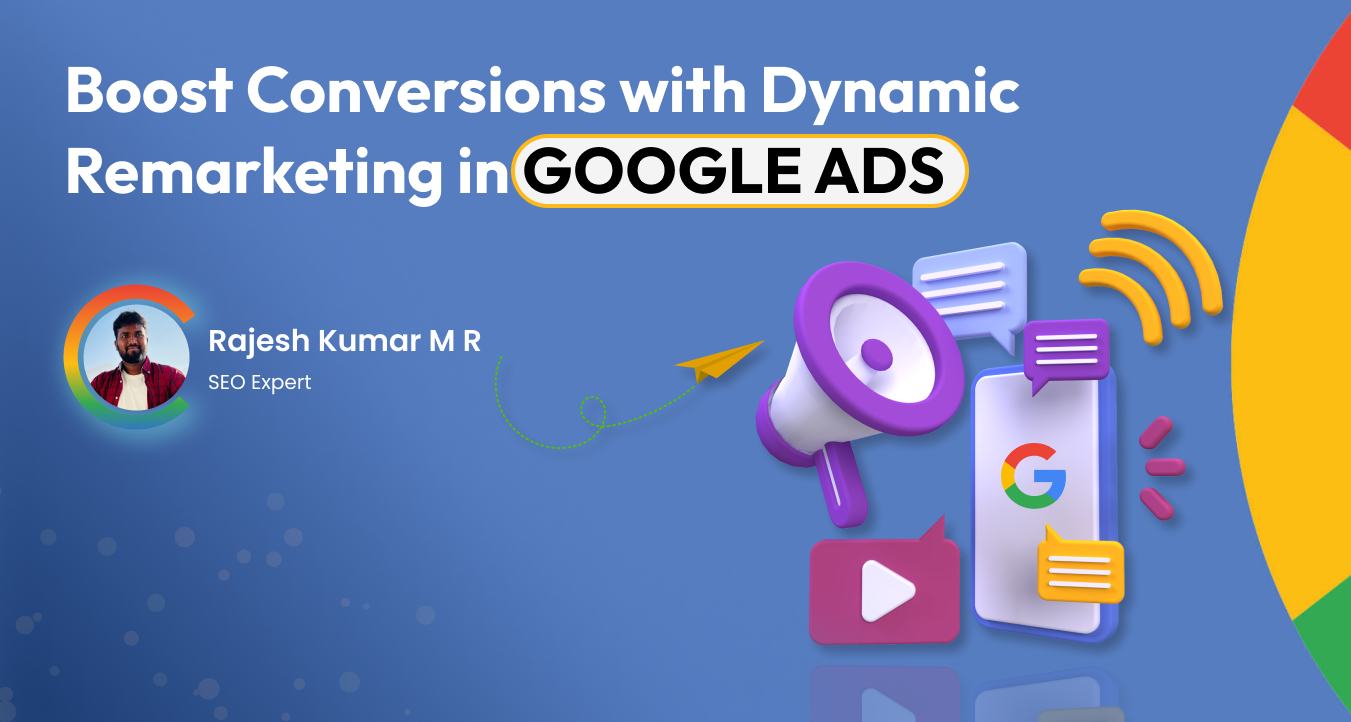Introduction
In the world of digital advertising, businesses are constantly looking for effective strategies to increase conversions and maximize their return on investment. One such strategy that has gained significant popularity is dynamic remarketing in Google Ads. With dynamic remarketing, businesses can reach out to potential customers who have already shown interest in their products or services, thereby increasing the chances of converting them into paying customers. In this blog post, we will explore the concept of dynamic remarketing and discuss how it can help boost conversions for your business.
What is Dynamic Remarketing?
- Dynamic remarketing is a high-level promoting approach that uses client information to convey customized advertisements to people who have communicated with your site or application. By following client conduct and activities, dynamic remarketing efforts can progressively produce and show fitted ads to catch the consideration of likely clients.
Here are a few examples of how you can leverage this strategy:
- Showcase specific products: Display ads featuring the exact products a user has previously viewed on your website, along with pricing and a call-to-action, to entice them to return and make a purchase.
- Recover abandoned carts: Remind users of items they left behind in their shopping carts through dynamic remarketing. Show ads with the abandoned products, along with discounts or incentives, to encourage them to complete the purchase.
- Cross-sell and upsell: After a user makes a purchase, use dynamic remarketing to display related or upgraded products. Show ads featuring complementary items or higher-priced alternatives to increase repeat purchases and average order value.
- Personalize based on attributes: Customize ads based on user attributes like location, device, or browsing history. Show location-specific offers or device-specific features to enhance relevance and engagement.
- Sequential messaging: Create a sequence of ads that guide users through the purchase funnel. Start with a general ad showcasing your brand, then follow up with more specific ads highlighting product features. Delivering a tailored series of messages keeps your brand top-of-mind and increases the likelihood of conversion.
- Dynamic remarketing uses a tracking pixel placed on your website or app to collect information about user behavior, such as the products they viewed, added to their shopping cart, or purchased. This data is then used to personalize the ads shown to each individual user.
- For example, if a user viewed a pair of shoes on your website, dynamic remarketing can display ads featuring those exact shoes, along with other related products, to remind the user of their initial interest and encourage them to make a purchase.
How Does Dynamic Remarketing Function?
Dynamic remarketing functions by leveraging user behavior data and dynamically generating personalized ads. Here's a step-by-step explanation of how it works:
- Tracking User Behavior: A tracking pixel or code snippet is placed on your website or app. When a user visits your site, the tracking pixel captures information about their interactions, such as the products they viewed, added to the cart, or purchased.
- Collecting User Data: The tracking pixel sends this user behavior data to a remarketing platform or system. The data is collected and associated with unique user identifiers.
- Creating a Data Feed: You create a data feed that contains information about your products or services. This includes details like product IDs, names, descriptions, prices, and images. The data feed acts as a source for dynamically generating ads.
- Dynamic Ad Generation: Using the user behavior data and the data feed, the remarketing platform dynamically generates personalized ads for each user. The system matches the user's behavior with relevant products or services in the data feed.
- Ad Display: The personalized ads are displayed to the user as they browse other websites or use mobile apps within the advertising network (e.g., Google Display Network). The ads can appear in various formats, including banners, text, or video.
- Ad Customization: The dynamic remarketing system customizes the ads to showcase the specific products or services that the user has shown interest in. This could include displaying the exact products they viewed or related items that complement their preferences.
- Real-Time Updates: As the user continues to interact with your website or app, the dynamic remarketing system continuously updates and adapts the ads in real time. This ensures that the displayed content remains relevant and aligned with the user's recent behavior.
- User Engagement: Personalized ads aim to re-engage the user by reminding them of their initial interest in your products or services. The ads may include compelling visuals, persuasive messaging, and enticing offers to encourage the user to click on the ad.
- Returning to Your Site: When the user clicks on the ad, they are directed back to your website or app, specifically to the relevant product or service page. This facilitates a seamless user experience and increases the chances of conversion.
- Conversion Tracking: The remarketing platform tracks conversions, such as purchases or sign-ups, that occur as a result of the dynamic remarketing campaigns. This data helps measure the effectiveness and ROI of the campaigns.
Advantages of Dynamic Remarketing
Customized Promotions: Dynamic remarketing empowers organizations to convey customized commercials that resound with individual clients. By exhibiting items or administrations they are now keen on, you increment the possibilities changing over them into clients.
Expanded Changes: Since dynamic remarketing targets clients who have proactively shown aim or are drawn in with your image, it altogether further develops transformation rates. By keeping your image on top of your brain and helping clients to remember their underlying interests, you can provoke them to make a buy.
Financially savvy: Contrasted with conventional promoting strategies, dynamic remarketing efforts frequently give a better yield on speculation (return on initial capital investment). By explicitly focusing on clients who are bound to change over, you can improve your promoting spending plan and augment its effect.
Adaptable Promotion Organizations: Google Promotions offers an assortment of promotion designs for dynamic remarketing, including text, picture, and even video promotions. This adaptability permits you to explore different avenues regarding various arrangements and find the ones that best resound with your crowd.
Further developed Promotion Importance: With dynamic remarketing, you can guarantee that your advertisements stay applicable to clients' inclinations, even as their inclinations advance. By continually refreshing your promotion content in light of client conduct, you keep a more elevated level of commitment and improve the probability of transformations.
Implementing Dynamic Remarketing in Google Ads
To implement dynamic remarketing in Google Ads, you need to follow these key steps:
- Set up a Google Ads account and create a remarketing tag: The remarketing tag is a code snippet that needs to be placed on your website or app to track user behavior and collect data for dynamic remarketing.
- Configure your data feed: A data feed is a file that contains information about the products or services you want to advertise. It should include details such as product IDs, names, descriptions, prices, and images. Ensure that the data feed remains up-to-date and accurate.
- Create dynamic remarketing campaigns: In Google Ads, you can create dynamic remarketing campaigns where you can set your budget, target audience, ad formats, and bidding strategies. Leverage the data feed to automatically generate personalized ads for each user based on their interactions with your website or app.
- Design compelling ad creatives: Develop visually appealing ad creatives that showcase your products or services effectively. Incorporate strong call-to-action statements and promotional offers to entice users to click on your ads and complete the desired action.
- Monitor and optimize your campaigns: Regularly monitor the performance of your dynamic remarketing campaigns. Analyze key metrics such as click-through rates, conversion rates, and return on ad spend. Use these insights to refine your targeting, ad creatives, and bidding strategies to maximize conversions.
Two remarketing examples in action
Here are two examples of remarketing ads that can inspire your strategy:
1. Nike
Nike is ranked first on our list of retargeting ad examples. A number of remarketing examples, such as the one below, were discovered while exploring other websites after looking for a new pair of running shoes on Nike's website.
This remarketing ad scrolled through several pairs of shoes that were "suggested for us" based on our previous web browsing activity on Nike's website. It also had a call-to-action (CTA) button that would send us back to Nike's website so we could complete our purchase.
2. Airbnb
The next remarketing ad example is derived from Airbnb. Airbnb's site or mobile app is constantly searched for a dreamy accommodation.
The following retargeting example showed up in our Facebook News Feed after a few listings were looked at.
A picture of a listing we had previously viewed is shown in the retargeted Facebook advertisement (look at that comfy hammock! ), along with a "Book Now" CTA button. The booking process is made even more convenient by the retargeted Facebook ad, which allows the booking to be completed with just a few clicks.
Conclusion
In Conclusion, dynamic remarketing is a powerful tool that enables advertisers to boost conversions by delivering personalized ads to users who have previously interacted with their website or mobile app. By leveraging user data and tailoring ads based on specific browsing history, dynamic remarketing keeps your brand in front of potential customers, increases engagement, and drives conversions. With its flexibility, scalability, and proven effectiveness, dynamic remarketing in Google Ads should be an integral part of your digital advertising strategy. Harness the power of dynamic remarketing and the expertise of a Google Ads agency in Bangalore to unlock new opportunities and effectively grow your business online.




